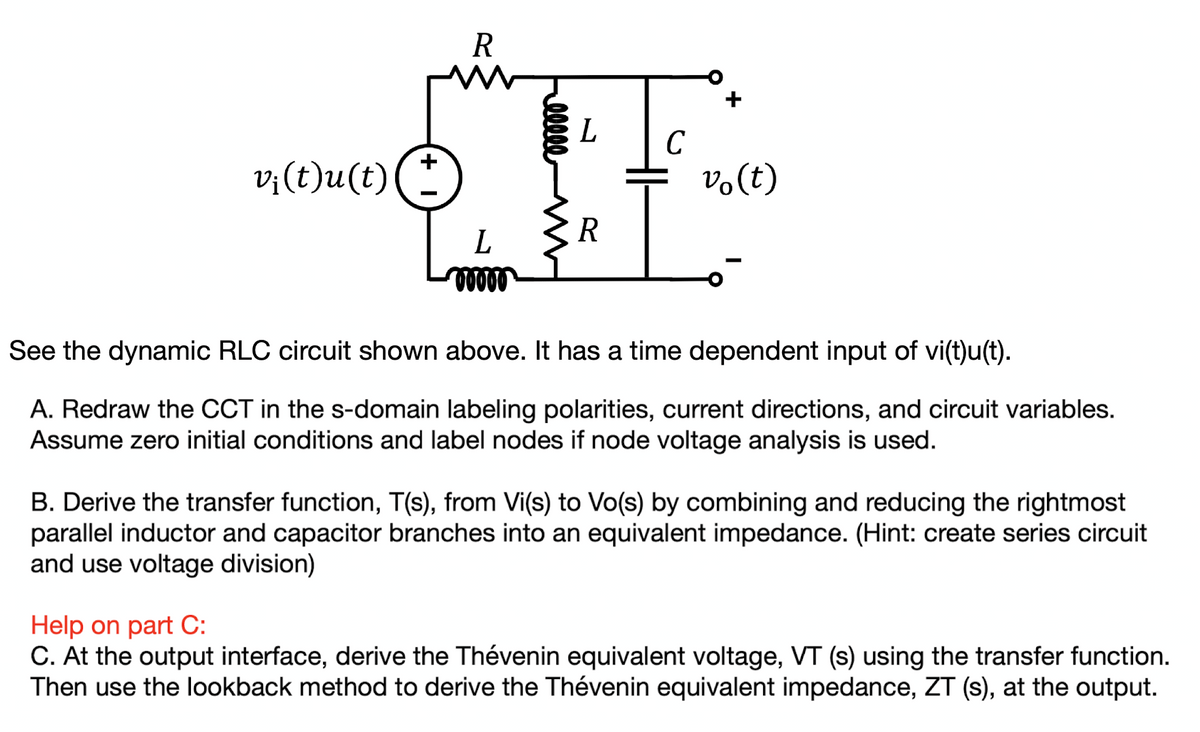vị(t)u(t) + R L eeeee C + vo(t) See the dynamic RLC circuit shown above. It has a time dependent input of vi(t)u(t). A. Redraw the CCT in the s-domain labeling polarities, current directions, and circuit variables. Assume zero initial conditions and label nodes if node voltage analysis is used. B. Derive the transfer function, T(s), from Vi(s) to Vo(s) by combining and reducing the rightmost parallel inductor and capacitor branches into an equivalent impedance. (Hint: create series circuit and use voltage division) Help on part C: C. At the output interface, derive the Thévenin equivalent voltage, VT (s) using the transfer function. Then use the lookback method to derive the Thévenin equivalent impedance, ZT (s), at the output.
vị(t)u(t) + R L eeeee C + vo(t) See the dynamic RLC circuit shown above. It has a time dependent input of vi(t)u(t). A. Redraw the CCT in the s-domain labeling polarities, current directions, and circuit variables. Assume zero initial conditions and label nodes if node voltage analysis is used. B. Derive the transfer function, T(s), from Vi(s) to Vo(s) by combining and reducing the rightmost parallel inductor and capacitor branches into an equivalent impedance. (Hint: create series circuit and use voltage division) Help on part C: C. At the output interface, derive the Thévenin equivalent voltage, VT (s) using the transfer function. Then use the lookback method to derive the Thévenin equivalent impedance, ZT (s), at the output.
Introductory Circuit Analysis (13th Edition)
13th Edition
ISBN:9780133923605
Author:Robert L. Boylestad
Publisher:Robert L. Boylestad
Chapter1: Introduction
Section: Chapter Questions
Problem 1P: Visit your local library (at school or home) and describe the extent to which it provides literature...
Related questions
Question

Transcribed Image Text:v¡(t)u(t)
R
L
00000
ellee
L
R
C
vo(t)
See the dynamic RLC circuit shown above. It has a time dependent input of vi(t)u(t).
A. Redraw the CCT in the s-domain labeling polarities, current directions, and circuit variables.
Assume zero initial conditions and label nodes if node voltage analysis is used.
B. Derive the transfer function, T(s), from Vi(s) to Vo(s) by combining and reducing the rightmost
parallel inductor and capacitor branches into an equivalent impedance. (Hint: create series circuit
and use voltage division)
Help on part C:
C. At the output interface, derive the Thévenin equivalent voltage, VT (s) using the transfer function.
Then use the lookback method to derive the Thévenin equivalent impedance, ZT (s), at the output.
Expert Solution
This question has been solved!
Explore an expertly crafted, step-by-step solution for a thorough understanding of key concepts.
Step by step
Solved in 5 steps with 4 images

Knowledge Booster
Learn more about
Need a deep-dive on the concept behind this application? Look no further. Learn more about this topic, electrical-engineering and related others by exploring similar questions and additional content below.Recommended textbooks for you

Introductory Circuit Analysis (13th Edition)
Electrical Engineering
ISBN:
9780133923605
Author:
Robert L. Boylestad
Publisher:
PEARSON

Delmar's Standard Textbook Of Electricity
Electrical Engineering
ISBN:
9781337900348
Author:
Stephen L. Herman
Publisher:
Cengage Learning

Programmable Logic Controllers
Electrical Engineering
ISBN:
9780073373843
Author:
Frank D. Petruzella
Publisher:
McGraw-Hill Education

Introductory Circuit Analysis (13th Edition)
Electrical Engineering
ISBN:
9780133923605
Author:
Robert L. Boylestad
Publisher:
PEARSON

Delmar's Standard Textbook Of Electricity
Electrical Engineering
ISBN:
9781337900348
Author:
Stephen L. Herman
Publisher:
Cengage Learning

Programmable Logic Controllers
Electrical Engineering
ISBN:
9780073373843
Author:
Frank D. Petruzella
Publisher:
McGraw-Hill Education

Fundamentals of Electric Circuits
Electrical Engineering
ISBN:
9780078028229
Author:
Charles K Alexander, Matthew Sadiku
Publisher:
McGraw-Hill Education

Electric Circuits. (11th Edition)
Electrical Engineering
ISBN:
9780134746968
Author:
James W. Nilsson, Susan Riedel
Publisher:
PEARSON

Engineering Electromagnetics
Electrical Engineering
ISBN:
9780078028151
Author:
Hayt, William H. (william Hart), Jr, BUCK, John A.
Publisher:
Mcgraw-hill Education,